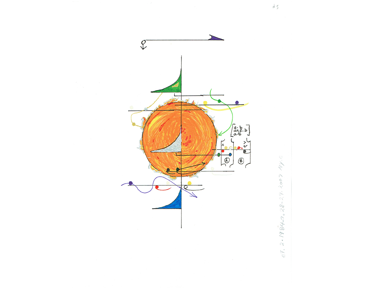Wadada Leo Smith: Ankhrasmation: The Language Scores, 1967-2015
@ The Renaissance Society
Cobb Hall, 4th Floor 5811 South Ellis Avenue Chicago, IL
Opening Sunday, October 11th, from 4PM - 7PM
On view through Thursday, October 29th
Trumpeter, composer, educator, and visual artist Wadada Leo Smith is a pioneer in the fields of contemporary jazz and creative music. As part of the program to celebrate the institution’s Centennial, the Renaissance Society presents the first comprehensive exhibition of Smith’s Ankhrasmation scores. These more than 45 works on paper include the first of Smith’s scores to use non-standard visual directions, The Bell, which was debuted on Anthony Braxton’s seminal 1968 recording, Three Compositions of New Jazz.
Experimental music has been a component of the Renaissance Society’s programming since the first concerts hosted in conjunction with the World’s Fair in Chicago in the 1930s. Organized by Hamza Walker and John Corbett, both of whom have at different times served as music curators at the Renaissance Society, this exhibition is accompanied by a series of related events, all of which are free and open to the public:
Opening reception Sun, Oct 11, 4–7pm, at the Renaissance Society
Panel: Ankhrasmation and Improvisation Sat, Oct 24, 4pm, at the University of Chicago’s Logan Center, 915 E 60th St, Chicago; with Wadada Leo Smith, Anthony Davis, John Corbett, and Hamza Walker
Concert: The Golden Quartet Sat, Oct 24, 7pm, at the Logan Center; with Smith, Davis, John Lindberg, and Mike Reed, and live visuals by Jesse Gilbert
Gallery walk-through Sun, Oct 25, 2pm, at the Renaissance Society; with Hamza Walker
Concert: Wadada Leo Smith Sun, Oct 25, 3pm, at the Renaissance Society; with live visuals by Jesse Gilbert
Corbett vs. Dempsey and the Renaissance Society will also republish Smith’s 1973 Notes (8 pieces) source a new world music: Creative music in an edition of 1000 with an introduction by John Corbett and a new text by Smith.
During the 1960s and early ‘70s, Smith was based in Chicago, where he was a key member of the Association for the Advancement of Creative Music (AACM). Largely recognized as a watershed organization in the history of jazz, the AACM is known for crafting a vibrant dialectic between improvised and formally scored music, and this year celebrates its 50th anniversary.
Smith was one the most active and articulate proponents of this exchange, legitimizing a formal ideology around improvised music and the illustrated score that he continues to build on to this day. Ankhrasmation—a neologism formed of “Ankh,” the Egyptian symbol for life, “Ras,” the Ethiopian word for leader, and “Ma”, a universal term for mother—is the systemic musical language that Smith has developed over nearly 50 years. The scores eschew (and at times incorporate) traditional notation in favor of symbolic compositions of color, line, and shape. These provide specific instruction for the seasoned improviser while allowing musicians to bring their own special expertise and individual strengths to each performance.
The Renaissance Society presentation runs in parallel to MCA Chicago’s exhibition The Freedom Principle: Experiments in Art and Music, 1965 to Now (July 11 to November 22, 2015), which features one of Smith’s four-panel scores.
Wadada Leo Smith was born in Leland, Mississippi in 1941 and trained with the U.S. Military band program, Sherwood School of Music, and Wesleyan University. A faculty member at The Herb Alpert School of Music at California Institute of the Arts until his retirement in 2013, Smith also taught at the University of New Haven, the Creative Music Studio in Woodstock, NY, and Bard College. A 2013 Pulitzer finalist, Smith was DownBeat Magazine’s 2013 “Composer of the Year” and the Jazz Journalist Association’s 2013 Musician of the Year and Trumpeter of the Year. In 2014 DownBeat magazine named him “One of the 80 Coolest Things in Jazz Today,” citing his “magisterial instrumental voice, his inspirational leadership, and his command of classical, jazz and blues forms to remind us of what’s gone down and what’s still happening.” The Jazz Journalists Association named him Composer of the Year in 2015.
Smith currently leads five principal ensembles: the Golden Quartet, Mbira, Organic, the Silver Orchestra; and TUMO and his compositions have been performed by other ensembles including AACM-Orchestra, Kronos Quartet, San Francisco Contemporary Music Players, New York New Music Ensemble, and California E.A.R. Unit. Recent awards and commissions include MAP Fund Award for “Ten Freedom Summers” (2011), Chamber Music America New Works Grant (2010), NEA Recording Grant (2010), Fellow of the John Simon Guggenheim Memorial Foundation (2009-2010). He has released more than 50 albums as a leader on labels including ECM, Moers, Black Saint, Tzadik, Pi Recordings, TUM, Leo and Cuneiform.
The Renaissance Society at the University of Chicago is committed to supporting ambitious artistic experimentation, primarily through the commissioning of new works, and to fostering rigorous, interdisciplinary discourse. In addition to the exhibition program, this independent, non-collecting museum hosts lectures, concerts, performances, screenings, and readings, and regularly publishes catalogues and artist books, which are distributed widely.
All of the Renaissance Society’s exhibitions and events are free and open to the public. The gallery is open during exhibitions Tuesday to Friday, 10am-5pm; Saturday and Sunday, 12-5pm; closed Monday.
The Renaissance Society turns 100 years old this year and celebrates with a special Centennial program of exhibitions and events from September 2015 to January 2016, including exhibitions by Irena Haiduk, Wadada Leo Smith, and Paul McCarthy; a presentation of archive materials from 1915 to 2015; a symposium addressing the role of the contemporary art institution; public programs on Gertrude Stein, visual arts on Chicago’s South Side, and more; and a significant new publication covering the Renaissance Society’s first century.
Official Website
More events on this date
Tags: Renaissance Society, University of Chicago, Wadada Leo Smith

« previous event
next event »